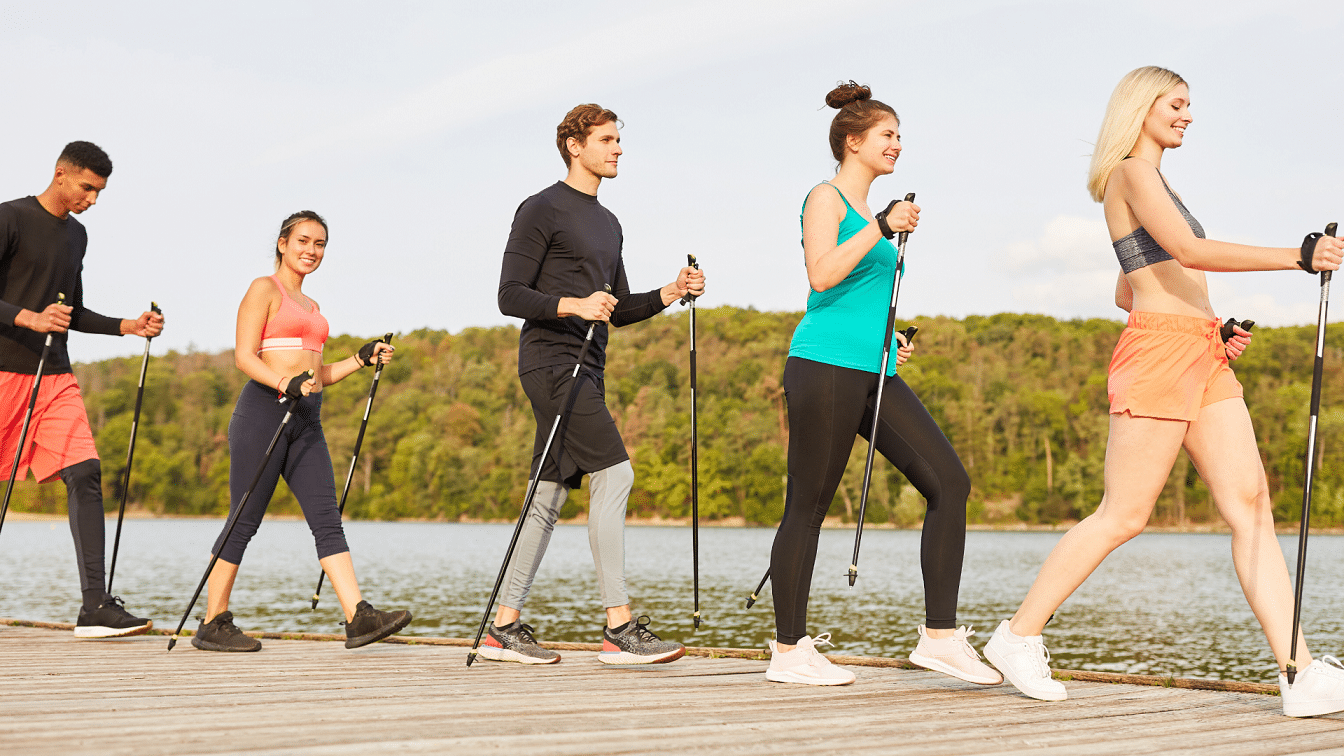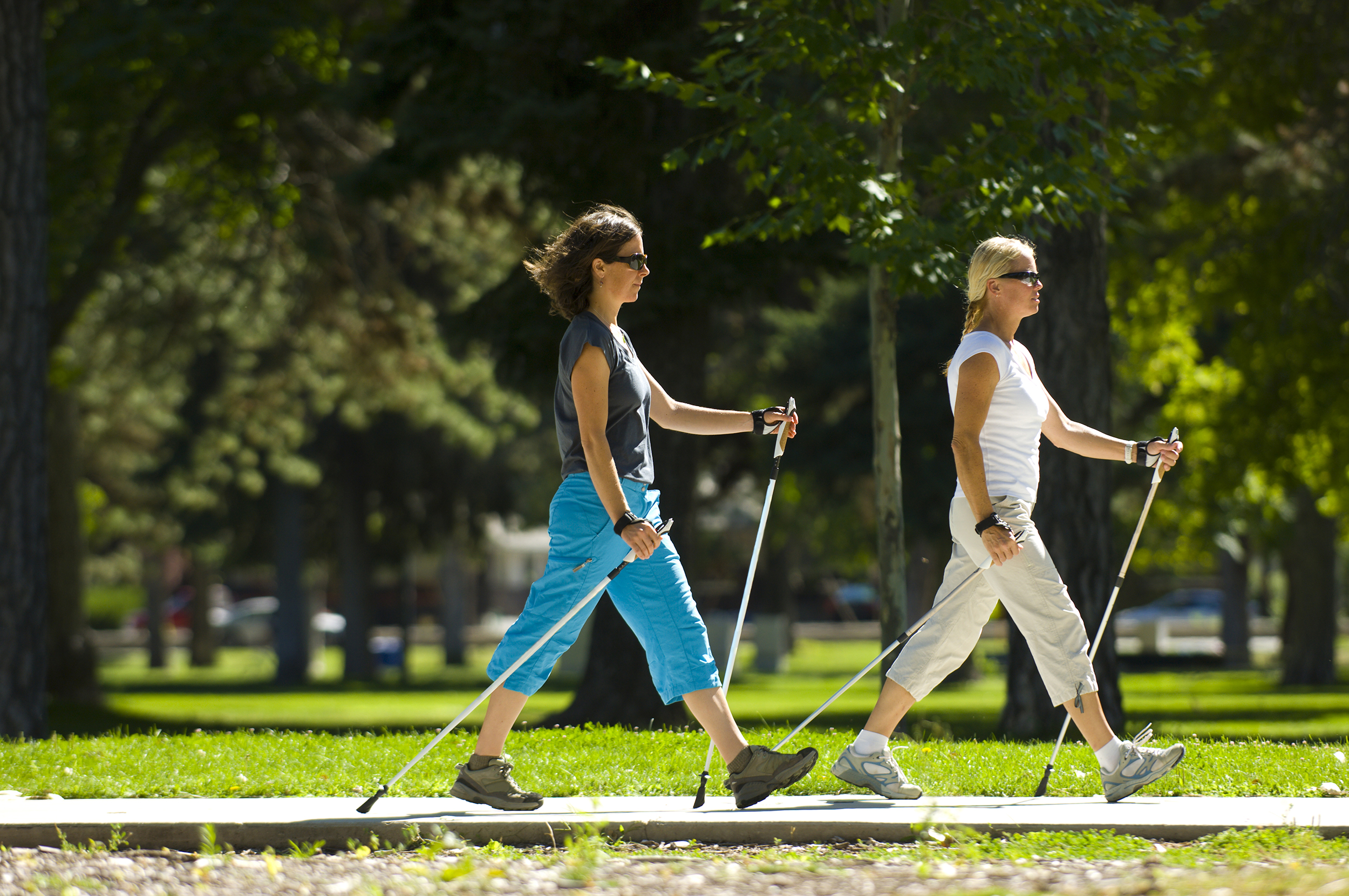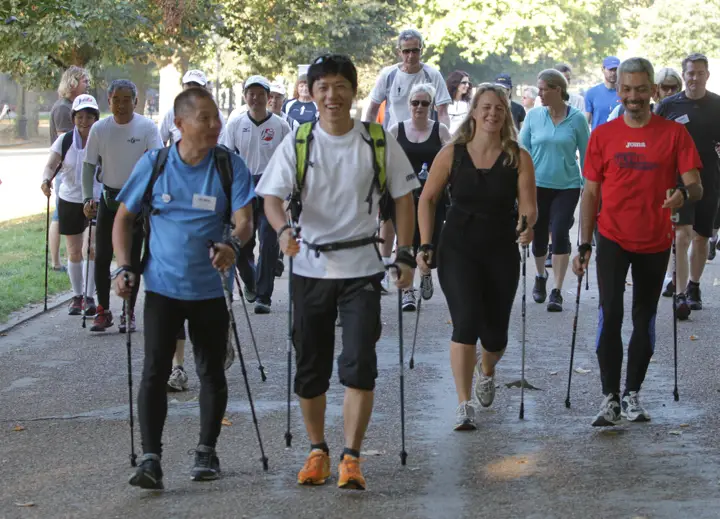Table of Contents
Nordic Walking- How Is It Different From Regular Walking?
Have you heard of Nordic Walking? How can you improve your total workout by walking without feeling like spending more energy? How can you avoid slouching and neck-shoulder pain caused by sitting at a desk or using a computer? Millions of European individuals have taken up Nordic walking to get a nice workout and loosen their neck and shoulders.
What Is Nordic Walking?
Nordic walking is a way to work out your upper body by walking with two specially made poles. Like cross-country skiing, the arms move the poles with each step; when you do Nordic walking, your intensity level increases because you use your arms.
Nordic walking isn’t the same as walking with poles to help you keep your balance or take pressure off your joints. When you do Nordic walking, the poles make you use more muscles and make the workout challenging.
In Nordic walking, the poles stay behind the body and become an extension of your arms. This differs from hiking with poles, where you keep them in front of you or next to you to help you keep your balance or take pressure off your joints, especially on rocky or downhill terrain. If you know how to use the poles correctly, you can ensure you get all the benefits of Nordic walking.
Health Benefits of Nordic walking

Nordic walking improves your heart rate without raising your perceived rate of exertion, making it a better yet simpler cardio workout. You get better exercise without having to push any harder. While walking faster can produce a similar heart rate effect, many people do not want to or are unable to walk quickly.
1. Upper Body Workout
Walking with arm weights is another popular way to work out your upper body while walking, but experts don’t recommend it. Arm weights stress joints, especially if you walk for the half-hour to 2 hours recommended for fitness.
Nordic walking uses the full range of motion in the arms, shoulders, upper chest, and back, stretching and lengthening muscles that are often tight. People tend to hunch forward when working at desks, reading, or watching TV. This motion helps people stop doing that. People often tense up the muscles in their neck and shoulders when stressed. When you do Nordic walking, those knots loosen up.
The upper body might also get stronger from Nordic walking. When you walk with poles, each step uses your arms, shoulders, and back muscles in a fast, pumping motion. A study from 2017 looked at office workers who did Nordic walking for 12 weeks. Researchers found that their trapezius muscles hurt less and could move their shoulders more. Researchers have even found that Nordic walking is a better way to build strength in the upper body than resistance training.
2. Stability and Posture
On any surface, the poles give walkers with trouble with their knees or legs more stability. Good posture is encouraged by the right way to use the poles and move your arms. People who had stopped walking for fun find they can do it again with the poles.
3. Relaxes the Upper Body
People who walk have used various methods and tools to work out their upper bodies while walking. Moving your arms in the right way can relieve tension in your neck and shoulders and strengthen your upper body.
Racewalkers use their arms well to work out their upper bodies.
Using the right technique for Nordic walking, with shoulders relaxed, poles behind the body, and a full range of motion relieves stress in the shoulders and neck. People often slouch at desks and computers, which can be corrected by taking a 30-minute walk and moving your arms and shoulders through their full range of motion.
4. Better Workout at the Same Speed
Adopting a fast walking method or racewalking is an excellent strategy to increase the intensity of your walking routine. However, Nordic walking poles are an option for people who have problems or prefer not to walk faster. Using the Nordic walking poles at your normal walking speed increases your workout without making you move faster. It is also a wise option for people whose walking partners are slow.
Furthermore, by including the upper body workout, calorie burn is enhanced by 10 to 20%. However, the walker feels no difference in how hard they exercise. Nordic walkers get a “full-body” workout without having to push any harder than walking.
Nordic walking burns more calories and improves the effectiveness of a fat-burning walking session. The majority of walkers will increase their workout by 10 to 20%.
5. Low impact
People suffering from joint stiffness or arthritis may use nordic walking as an alternative to typical types of aerobic exercise.
Walking with poles helps redistribute weight, reduce joint loading, and build muscular strength. It may assist in alleviating the pain associated with prolonged high-impact exercise, such as jogging.
While some people may find the use of poles beneficial, several studies say there is little difference in cumulative impact between normal and Nordic walking.
6. Good for heart health

Nordic walking is a great low-impact exercise for anyone looking to improve their cardiovascular fitness.
By engaging your upper-body muscles, your body needs more blood to be carried out through your heart, requiring more use of your cardiovascular and respiratory systems.
Even so, Nordic walking increases your RPE (rate of perceived exhaustion) slightly more than regular walking. It suggests that you don’t notice a big difference in intensity, even though your body is working harder.
A short review of 8 studies on people with heart disease found that those who participated in Nordic walking programs had much better exercise capacity, activity duration, and oxygen uptake than those who participated in specific cardiac rehabilitation programs.
Another study on heart failure patients found that those who engaged in a Nordic walking program improved significantly in VO2 max (a measure of lung capacity), exercise duration, and 6-minute walking test compared to the control group.
How can Nordic walking help with arthritis?
Arthritis is an inflammation of the joints either for a short time or a long time. Even though arthritis can’t be cured, exercise may help ease the pain.
Nordic walking is a low-impact exercise that puts less stress on the joints and builds muscle strength, which may help ease arthritis pain.
People with arthritis may benefit just as much from low-impact, low-intensity exercise. One study showed that this exercise helped ease arthritis pain as much as high-intensity exercise.
In another study, people with osteoarthritis who did Nordic walking had more hip range of motion, longer strides, and better fitness. Also, compared to home-based exercise, it significantly reduced how much pain was felt.
Arthritis pain may need more than one treatment (like medicine and physical therapy), but Nordic walking is a low-impact exercise that is inexpensive and may help relieve arthritis pain.
Is Nordic walking risky in any way?
For many people, nordic walking is a safe and efficient way to work out.
Still, you should talk to a doctor or nurse first if you have any injuries or have been told to avoid certain kinds of exercise.
Using Nordic poles to walk may also take some time to get used to. So, the best place to try Nordic walking is on a flat surface before moving on to uneven surfaces or hills.
Lastly, practicing the right way to use the poles will ensure you use them correctly and work for the right muscle groups.
What gear is required for Nordic walking?
For Nordic walking, all you need are walking poles and shoes made for walking.
You’ll want to make sure you buy the right Nordic walking poles since they’re made for the unique way Nordic walkers walk and hold their poles.
The poles weigh about 0.5 pounds (0.23 kg) and have a small grip with hand straps that can be removed. These straps help you hold the poles correctly and keep them from falling over.
In Nordic walking, your hands do not completely wrap around the pole. They are, however, mainly open. You walk with the poles, almost as if you’re pulling them behind you. Having the proper straps is critical for effective technique.
Also, Nordic walking poles usually have tips made of both rubber and steel. The rubber rests on the steel tips and works well on flat surfaces like asphalt. These tips can be taken off to reveal sharp steel tips that are good for uneven surfaces like grass or hiking trails.
This is different from ski poles or hiking poles, which usually have much bigger grips and wrist straps on the tops of the grips. These are not made for such kind of a walking, so you won’t get the benefits this exercise offers for your whole body.
Proper technique for Nordic walking

To make the most of your workout, ensure you’re walking correctly. Here’s how to do it:
- Stand tall, shoulders relaxed, chest lifted, and gaze straight ahead.
- Hold a pole in each hand backward at a diagonal angle (They should be at an angle so that the pole’s base is behind you.) Your hand should barely touch the pole.
- As you move forward with your left foot, bring the right pole forward so its base lands on the ground next to you.
- As you step forward with your right foot, push the pole into the ground behind you. As your arm goes all the way out, let go of your grip so that your palm is fully open. This gives your arm a wider range of motion and keeps your wrist from getting hurt.
- When this happens, move your right foot and left pole forward. When the left pole lands, close your grip to push it off the ground and keep going.
The main difference between regular and this kind of walking is how the poles are used and where they are placed. Ensure the poles are always at an angle and never in your way.
Final words:
This is for you if you enjoy walking but want a bigger challenge.
Nordic walking allows you to walk quicker by using specific poles. Because you’re swinging the poles with your arms, you’re working your upper and lower body for a full-body workout.
This boosts your cardiovascular exertion without making you feel like running a marathon.
It’s also ideal for people seeking a low-impact cardio workout, such as older adults or those suffering from arthritis or knee problems.
You can get a terrific workout with such a walking style if you have the correct poles and shoes.
FAQs
Is Nordic walking better than just walking?
It’s better than just walking because it gives you a better cardio workout by making your heart beat 5–17 beats per minute faster without making you feel like you’re working out more. It also works out the upper body’s shoulders, arms, chest, and back muscles.
How is Nordic walking different from walking?
When walking with Nordic poles, you use more muscles and burn more calories than walking without them. Imagine a bright blue sky above a huge field of fluffy, new snow. You’re ready for a day of cross-country skiing. The air is cool, and you’re on skis and ready to move across the white space.
What Nordic walking means?
It is a walking style that uses poles to work your upper and lower body. It provides an effective all-over workout that does not feel like one! Nordic Walking is a joyful and social sport that may be done in urban centers or in the open countryside all year.
What are some disadvantages of Nordic walking?
Some problems with Nordic walking are that it’s costly, the techniques are hard and take a long time to learn, it’s uncomfortable, and it can get in the way of doing simple things.
Can I lose weight by Nordic walking?
According to studies from the University of Verona, Nordic Walking is a more effective workout strategy for weight loss than regular walking. This study, published in the journal Clinical Interventions in Aging, illustrates the effectiveness of Nordic Walking in decreasing obesity and overweight in middle-aged persons.
How long should I Nordic walk?
The length of your Nordic walking poles should be about 70% of your total height. When the pole is straight up from the ground, your elbow should be bent at a 90-degree angle (the elbow should be glued to the waist and pole tip touching the ground).
Is Nordic walking better than running?
It’s like running fast without the impact. A study in the Journal of Biomechanics found that oxygen uptake at 7.7 km/h was 16 percent higher with Nordic walking than with running. To take in the same amount of oxygen, you must run at a speed of 9.8 km/h.
What equipment is required for Such walking?
For this workout, you don’t need much gear. You only need a pair of poles, shoes made for Nordic-style walking, sportswear, and a small backpack. So all you need is to get the right gear and start Nordic walking!
What are the advantages of Nordic walking?
- It’s entertaining – and anyone can do it!
- Aids in weight loss.
- It strengthens your bones and tones your muscles.
- It guards your hip and knee joints.
- It improves asthma symptoms by strengthening the heart and lungs.
- Improves circulation.
- Improves lymphatic drainage.
- Mental wellness.


